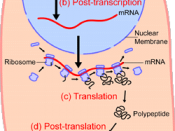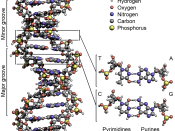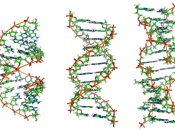A)Briefly describe the structure of the nucleic acids DNA and RNA. (6)
B)How do their differences in structure suit the different roles in which they play in living cells. (10)
C)What is meant by the term 'the genetic code' (4)
a)
DNA are much the same in a number of aspects. Both are built up of large polymer chains of nucleotides. DNA is much longer than RNA (DNA-1 billion base pairs and RNA - 10,00 bases) but are both long threadlike macromolecules.
This basic diagram of a nucleotide is correct for both DNA and RNA, the only difference is that the pentose sugar in the center is deoxyribose for DNA and ribose for RNA. The nucleotides are binded together between the phosphate of one and the sugar of the next. The bond used is a strong diester linkage. The strands are sequences of these nitrogen-containing bases. There are 4 different types of bases, adenine (a), guanine (g), thymine (g) and cytosine (c) but in RNA thymine is replaced with uracil (u).
Each base is complementary to another and so DNA is made up of complementary base pairs. Adenine and Guanine are Purine whereas Thymine and Cytosine are Pyrimidines. Purines have two ring strucutres and pyrimidines have only one ring. Because of this purines can only bind to pyrimidines and vice versa thus setting up the links for A-T and G-C. In DNA, there are two strands of nucleotides. They are complementary and antiparallel. This means that the codes are opposite and so bind to each other and run in opposite ways. An example would be where one side runs ATCG, the other would run CHAT and so they would bond together between the bases with a hydrogen bond. RNA is mostly single stranded except for in some viruses. The code...


